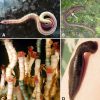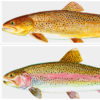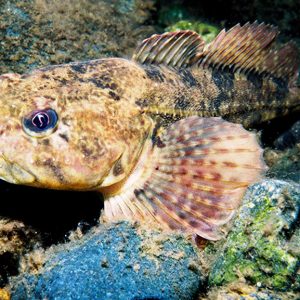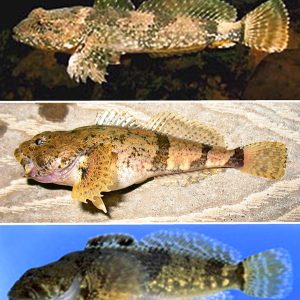calsfoundation@cals.org
Sculpins
aka: Cottids
Sculpins belong to the order Scorpaeniformes and superfamily Cottoidea. There are about 11 families, 149 genera, and 756 species. They reach their maximum diversity in the northern Pacific Ocean. The family Cottidae is the largest family, with approximately 258 species; the second-largest family is the Agonidae (marine poachers), with 47 species. The most speciose genus, Cottus (freshwater sculpins), is confined to North America and Eurasia. It includes about 68 taxa that are native to the Northern Hemisphere (Palearctic and Nearctic realms). There is fossil material similar to Cottus that dates to at least the Miocene Epoch (23 to 5.3 million years ago).
Most sculpins are generally less than 15 centimeters (6 inches) in length, although a few species can reach twice that size. The great sculpin (Myoxocephalus polyacanthocephalus) is a marine species that can attain 80 centimeters (31.5 inches) in length and 9 kilograms (20 pounds) in weight.
Sculpins inhabit many types of cooler benthic habitats, including primarily marine but also freshwater zones. They live in kelp forests, rivers, submarine canyons, and tidepools. Morphologically, sculpins possess large fan-shaped pectoral fins with a single spine on the upper edge with two to five sharp fin rays along the lower edge, an adaptation that makes them specialized for adhering to the bottom substrate and anchoring themselves in swift current. Most species are nearly scaleless; a lateral line is either present, incomplete, or absent; there is no swim bladder; and they have large heads and mouths with large dorsally placed eyes.
In Arkansas, there are three species of sculpins, including the mottled sculpin (Cottus bairdii), banded sculpin (C. carolinae), and the recently described knobfin sculpin (C. immaculatus). The Ozark sculpin (Cottus hypselurus) was once included in the Arkansas fish fauna but is now known to only inhabit the Black, Gasconade, and Osage river drainages in Missouri.
The mottled sculpin is widespread, although it is highly disjunct throughout North America from Arctic Canada (southern Alberta, British Columbia, northern Quebec, Labrador, and Manitoba) south to the Mobile and Tennessee River drainage systems and northern parts of Mississippi, Alabama, Georgia, and South Carolina, and west of the Continental Divide to streams in the Rocky Mountains of Nevada, Idaho, and Montana. In Arkansas, C. bairdi is found in the White and Spring river drainages of the Ozarks; it also occurs in the Little Black River, a tributary to the Current River. Favored habitat of C. bairdi is well-oxygenated, clear water with moderate velocities between 0.20 to 0.38 meters/second, such as over gravel riffles in mountain streams, springs, and along rocky lake shores.
This sculpin has a ground coloration of coppery brown to slate gray, but breeding (nuptial) males may be nearly black. There is a combination of randomly distributed bars, saddles, spots, and speckles, and its large pectoral fins are banded. Like a chameleon, it can modify its color to match the background. The first dorsal fin has seven to eight rays, and the second dorsal fin has 16 to 18 soft spines. Anal fin rays number 11 to 14, and there are 14 to 17 pectoral rays. The palantine teeth are either well developed or absent, and the lateral line is incomplete (ending beneath the second dorsal fin). Concealed beneath the skin are reduced preopercular spines; the lowest two are curved downward and problematic to see. The ventral peritoneum has moderate to strong pigmentation. The maximum length of C. bairdi is about 11 centimeters (4.5 inches). Even the most experienced ichthyologist can confuse the two and make identification errors when C. bairdi is sympatric with C. carolinae.
Cottus bairdi is an ambush predator that feeds primarily on bottom-dwelling aquatic insect larvae, but it will also eat some plant material, crustaceans, and small fish (and their eggs), including other mottled sculpins and trout. However, their overall impact on trout eggs is probably negligible. This cottid has not been reported to be a major threat to game fish. However, it is preyed upon by other fish, such as brook and brown trout, northern pike, and smallmouth bass (all of which are present in Arkansas). Anglers using worm bait sometimes catch sculpins and use them as bait for brown trout.
Mottled sculpin reach sexual maturity at the age of two and have an average lifespan of about six years. The breeding season for C. bairdi is during mid-March to May. Clutch size in the southern part of their range averages 60 ova per female, but, because males can mate with several females that deposit their eggs beneath stones or other objects, there may be as many as 1,587 eggs in the nest. After mating, females may leave the nest area but are more often chased away by the male. The males continue to guard the eggs until they hatch in two to three weeks, when new hatchlings absorb their yolk sac, and fry are then ready to disperse.
The banded sculpin (C. carolinae) also has a widespread distribution in eastern North America west of the Appalachians and south of the Ohio River Valley from upland streams in the Mississippi River basin and upper Tennessee River drainage to Virginia, Kentucky, Tennessee, southern Indiana, and southern Illinois south to upland and lowland streams of the Alabama River drainage; Georgia and Alabama; and west to the Ozark Mountain drainages of southern Missouri, northern Arkansas, and northeastern Oklahoma. There are three recognized subspecies of C. carolinae: C. c. carolinae, C. c. infernalis, and C. c. zopherus. In Arkansas, C. c. carolinae is found in small to moderately sized cool upland streams in areas of swift current of the White River system and disjunctly in the Illinois River system of the northwestern part of the state. Young and juvenile C. carolinae can be found mainly in pools, riffles, and other shallow habitats, while adults tend to prefer deeper waters. They are sometimes observed in entrance zones and outflows of subterranean grottos, sinkholes, and caves (such as Searcy Cave in Independence County), but these populations generally resemble the epigean population and, as such, are considered accidental visitors. The grotto sculpin (C. specus), formerly considered an unusual form of banded sculpin, has recently been found to be a separate species. It lives in five caves and one stream in Perry County, Missouri, and has specific adaptations for a subterranean life. This sculpin is a federally endangered species.
The banded sculpin is variable in color depending on water clarity and substrate. The body is usually reddish brown or yellow with three dark black vertical saddles extending down the sides. It has a large flattened head with large eyes and large mouth and a naked scaleless body. The upper preopercle has a sharp spine, but lower ones are usually concealed below skin. It possesses a complete lateral line that usually ends at the base of the caudal fin, the first dorsal fin has six to nine weak spines, the second dorsal fin has 15 to 19 soft rays, and the anal rays number 11 to 16. The palantine teeth are well developed and are usually neighboring the vomerine tooth patch. Maximum length of C. carolinae is about 19 centimeters (7.3 inches).
Banded sculpins are primarily nocturnal ambush predators that stalk and eat crayfish, isopods, larval caddisflies, stoneflies, mayflies, and dipterans (midges), with some predation on small fishes (mostly darters). An Oklahoma salamander, Eurycea tynerensis was found in the stomach of a C. carolinae in Oklahoma. Banded sculpins are preyed upon by larger fish, most often trout but also piscivorous mammals, water snakes, aquatic turtles, and birds.
Reproduction in C. carolinae is in early spring, with males (like C. bairdi) carefully guarding the eggs until they hatch. The spawning period for C. carolinae is relatively short, lasting less than two weeks, with fecundity averaging 475 ova per female. Spawning occurs underneath cobble or other objects, and eggs are deposited in large clumps. The lifespan of C. carolinae averages four years.
The knobfin sculpin (C. immaculatus) is a recently described cottid distinguished from all members of the genus Cottus by using genetic and morphological characters. It is restricted to the Current, Eleven Point, Spring, White, and Black river basins in the Ozark Highlands of Arkansas and Missouri. In the upper Current River, C. immaculatus is the only sculpin present upstream of Akers Ferry (Spring Valley Township, Missouri); however, downstream of Akers Ferry, C. immaculatus is sympatric with C. carolinae. A recent record of C. immaculatus was reported from the Little Red River near the outflow of the Heber Springs Trout Hatchery (Cleburne County). As the native range of C. immaculatus does not connect with the Little Red River, this range expansion is most likely the result of human activity. Like other Arkansas cottids, it prefers rocky riffles of headwaters and cool to cold spring-fed creeks and rivers with cobble bottoms.
Overall body coloration of C. immaculatus is dusky and mottled with a background color of brown to olive. There are three to five horizontal rows of wide saddles on a light background. Pigmentation of the ventral surface of the peritoneum is weak. The anal fin rays number 13 (rarely, 12 or 14), dorsal fin spines number 8 (rarely, 7 or 9), dorsal fin rays are usually 17 to 18, pectoral fin rays are usually 16, and there are four (rarely, 3) pelvic fin rays. Males possess tips of the first dorsal spines thickened into small fleshy knobs. This morphological character is an unreported but possibly widespread character in the genus Cottus. This sculpin reaches a maximum length of nine centimeters (3.5 inches).
Nothing has been published on the food habits of C. immaculatus. Since this species was previously referred to as C. hypselurus in Arkansas, it was reported to feed on crayfish, trichopterans, plecopterans, mayflies, and dipterans, as well as gastropods, beetles, and miscellaneous animal material.
Although little is available on reproduction of C. immaculatus, it most likely spawns in cavities, and egg masses have also been found attached to the undersides of rocks. Spawning males have been reported to possess a blue chin and belly. Limited data suggests spawning occurs in March and April. Two different egg clusters of C. immaculatus were retrieved in March from the Spring River at Many Islands Campground (Fulton County). The egg clusters were orange and consisted of approximately 50 to 80 eggs in each mass.
Concerning parasites, twenty C. immaculatus from the Spring River (Fulton County) were examined but harbored none. However, several parasites, ranging from protozoans to crustaceans, are known from C. bairdi from other parts of its range, but none have been reported from Arkansas populations. In 2014, parasites were reported for the first time in C. carolinae from Arkansas. More recently, a new species of digenetic trematode (Plagioporus carolini) was described from the intestines of Arkansas C. carolinae collected from Flint Creek at Springtown (Benton County).
For additional information:
Adams, Ginny L., Brooks M. Burr, J. L. Day, and D. E. Starkey. “Cottus specus, a New Troglomorphic Species of Sculpin (Cottidae) from Southeastern Missouri.” Zootaxa 3609 (2013): 484–494.
Adams, Susan B., and David A. Schmetterling. “Freshwater Sculpins: Phylogenetic to Ecology.” Transactions of the American Fisheries Society 136 (2007): 1736‒1741.
Burr, Brooks M., Ginny L. Adams, Jean K. Krejca, Regina J. Paul, and Melvin L. Warren. “Troglomorphic Sculpins of the Cottus carolinae Species Group Perry County, Missouri: Distribution, External Morphology, and Conservation Status.” Environmental Biology of Fishes 62 (2001): 279‒296.
Burr, Brooks M., and Melvin L. Warren Jr. “Nests, Eggs, and Larvae of the Ozark Sculpin, Cottus hypselurus.” Copeia 1988 (1988): 1089‒1092.
Cashner, Robert C. “A Survey of the Fishes of the Cold Tailwaters of the White River in Northwestern Arkansas, and a Comparison of the White River with Selected Warm-Water Streams.” MS thesis, University of Arkansas, 1967.
Connior, Matthew B., Chris T. McAllister, Henry W. Robison, and Charles R. Bursey. “Status of an Exotic Salamander, Desmognathus monticola (Caudata: Plethodontidae), and Discovery of an Introduced Population of Cottus immaculatus (Perciformes: Cottidae) in Arkansas.” Journal of the Arkansas Academy of Science 67 (2013): 165‒167. Online at http://scholarworks.uark.edu/cgi/viewcontent.cgi?article=1277&context=jaas (accessed April 30, 2019).
Cooper, H. R. “Food and Feeding Selectivity of Two Cottid Species in an Ozark Stream.” MS thesis, Arkansas State University, 1975.
Downhower, J. F., and R. Yost. “The Significance of Male Parental Care in the Mottled Sculpin, Cottus bairdi.” American Zoologist 17 (1977): 936.
Dunn, D. M. “Determining the Possible Limitations by Cottid Species on Brown Trout Populations in the Bull Shoals Lake Cold Tailwaters.” MS thesis, Arkansas State University, 1999.
Etnier, David A., and Wayne C. Starnes. The Fishes of Tennessee. Knoxville: University of Tennessee Press, 1993.
Fayton, Thomas J., Chris T. McAllister, Henry W. Robison, and Matthew B. Connior. “Two New Species of Plagioporus (Digenea: Opecoelidae) from the Ouachita Madtom, Noturus lachneri, and the Banded Sculpin, Cottus carolinae, from Arkansas.” Journal of Parasitology 104 (2018): 145‒156.
Hoffman, Glenn L. Parasites of North American Freshwater Fishes. 2nd ed. Berkeley: University of California Press, 2009.
Kinziger, Andrew P. “Evidence Supporting Two New Forms and One Previously Described Race Within the Cottus carolinae Species-Complex from the Ozark Highlands.” American Midland Naturalist 149 (2003): 418–424.
Kinziger, Andrew P., and Robert M. Wood. “Cottus immaculatus, a New Species of Sculpin (Cottidae) from the Ozark Highlands of Arkansas and Missouri, USA.” Zootaxa 2340 (2010): 50‒64.
———. “Molecular Systematics of the Polytypic Species Cottus hypselurus (Teleostei: Cottidae).” Copeia 2003 (2003): 624–627.
Lee, David S. “Cottus bairdi (Mottled Sculpin).” In Atlas of North American Freshwater Fishes, edited by David S. Lee, et al. Raleigh: North Carolina State Museum of Natural History, 1980.
———. “Cottus carolinae (Banded Sculpin).” In Atlas of North American Freshwater Fishes, edited by David S. Lee, et al. Raleigh: North Carolina State Museum of Natural History, 1980.
McAllister, Chris T., Charles R. Bursey, Henry W. Robison, David A. Neely, Matthew B. Connior, and Michael A. Barger. “Miscellaneous Fish Helminth Parasite (Trematoda, Cestoidea, Nematoda, Acanthocephala) Records from Arkansas.” Journal of the Arkansas Academy of Science 68 (2014): 78‒86. Online at http://scholarworks.uark.edu/cgi/viewcontent.cgi?article=1226&context=jaas (accessed April 30, 2019).
McAllister, Chris T., Matthew B. Connior, William F. Font, and Henry W. Robison. “Helminth Parasites of the Banded Sculpin, Cottus carolinae (Scorpaeniformes: Cottidae), from Northern Arkansas, U.S.A.” Comparative Parasitology 81 (2014): 203‒209.
Miller, Rudolph J., and Henry W. Robison. Fishes of Oklahoma. Norman: University of Oklahoma Press, 2004.
Pflieger, William L. The Fishes of Missouri. Jefferson City: Missouri Department of Conservation, 1997.
Phillips, Edward, and Raj V. Kilambi. “Food Habits of Four Benthic Fish Species (Etheostoma spectabile, Percina caprodes, Noturus exilis, Cottus carolinae) from Northwest Arkansas Streams.” Southwestern Naturalist 41 (1996): 69‒73.
Robins, C. Richard, and Henry W. Robison. “Cottus hypselurus, a New Cottid fish from the Ozark Uplands, Arkansas and Missouri.” American Midland Naturalist 114 (1985): 360–373.
Robison, Henry W., and Thomas M. Buchanan. Fishes of Arkansas. 2nd ed. Fayetteville: University of Arkansas Press, 2020.
Robison, Henry W., David A. Neely, Uland Thomas, Ken E. Shirley, James K. Whalen, and Chris T. McAllister. “New Distributional Records and Natural History Notes on Selected Fishes from Arkansas.” Journal of the Arkansas Academy of Science 67 (2013): 115‒120. Online at http://scholarworks.uark.edu/cgi/viewcontent.cgi?article=1268&context=jaas (accessed April 30, 2019).
Ross, Stephen T. The Inland Fishes of Mississippi. Jackson: University Press of Mississippi, 2001.
Chris T. McAllister
Eastern Oklahoma State College
 Annelids
Annelids Salmonids
Salmonids Science and Technology
Science and Technology Sculpin
Sculpin  Sculpins
Sculpins 




Comments
No comments on this entry yet.